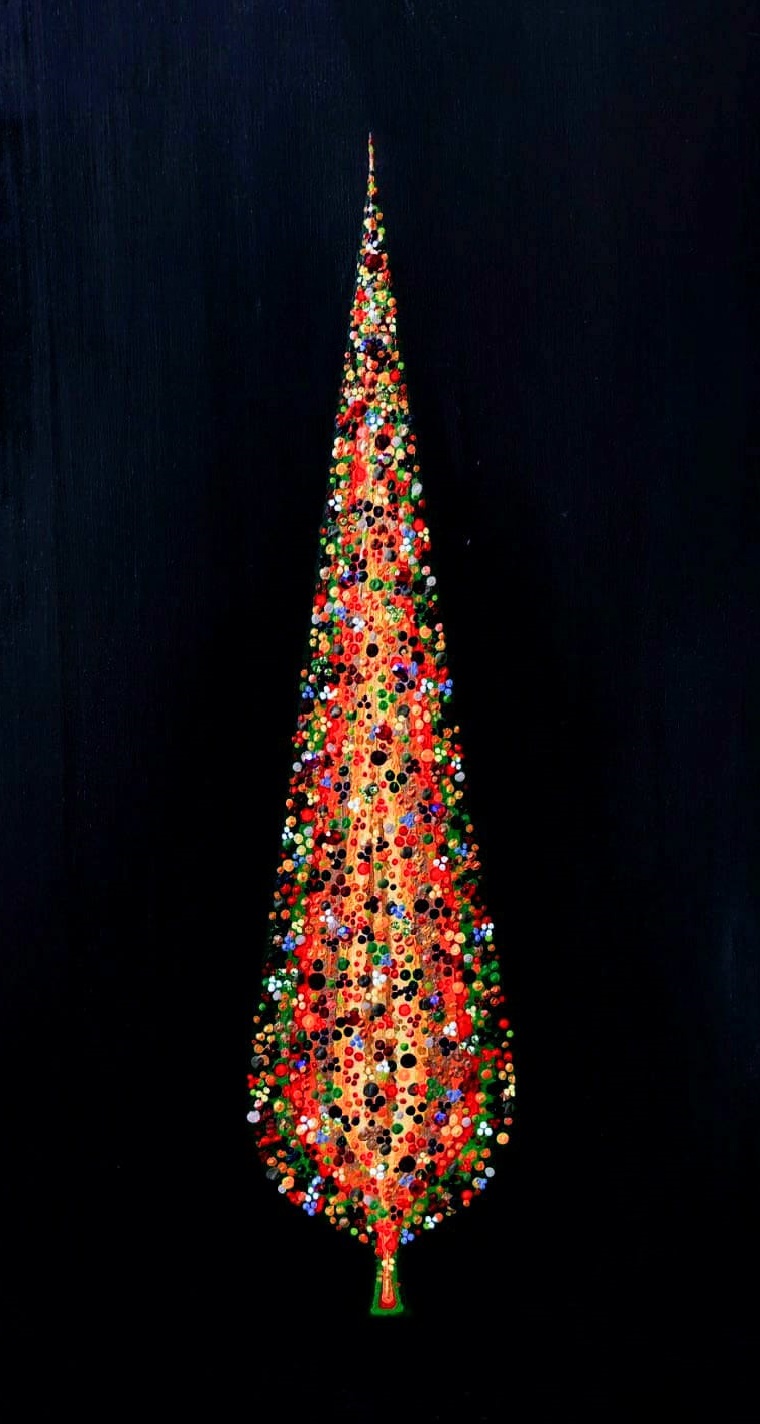- Year 2020
- Media Wooden panel, acrylic paint, golden metallic gilding paste, crystals elements
- Dimensions 80 x 40 cm
- Availability This painting is available for purchase. Price on request. Please don't hesitate to contact me.
- GALLERY
NO MATTER HOW STRONG THE WIND BLOWS, I WILL NOT BRAKE… CYPRESS TREE (Venetian Cypress Tree)
The next painting is called “NO MATTER HOW STRONG THE WIND BLOWS, I WILL NOT BRAKE…CYPRESS TREE”.
We often encounter the cypress tree in the works of various artists depicted as a variation of the Tree of Life motif ((for example, it appears in the “Shahnameh,” a Persian epic by Ferdowsi (approx. 932 – 1020)). The cypress symbolizes death, but it also signifies eternal life. It is one the most popular trees planted in Persian gardens. We see its motif woven into the imagery of Persian garden carpets and scarve-making traditions.
For me personally, the cypress is one of the proudest, most agile and resilient trees, aiming upwards to the skies. A quite sturdy and flexible tree, it usually shows up in almost all of my solo exhibitions and it adorns the home page of my website.
This work is part of the cycle of paintings called “Trees and Flowers in Time” that I have been working on for a very long time and keep returning to. It is representative of my style of utilizing crystal elements whose ability to reflect light is very strong and gives the image a magic-like appearance.
A large number of my paintings have black as their background, including this one. The idea for this originates in my first cycle of paintings devoted to the Balkans under the motto “The Balkans – Captured Moments” (1998 – 2000), as well as a subsequent exhibition in Izmir, Turkey called “Neighbours” (2002). Held in the midst of the Yugoslav wars at the time, the “Balkans” represented a mosaic of impressions of the historical cohabitation of different ethnic groups on this small strip of land.
This mosaic was expressed through the architecture of various temples (churches, synagogues, mosques), often positioning them in close proximity of one another and showing their similarities, shared traditions, heroes associated with them, etc. All paintings in this collection were on black background because the Balkans were often regarded as a dark place (“temnitza” as coined by the Yugoslav novelist, poet and short story writer Ivo Andric, the 1961 Nobel laureate) or a dungeon. The “Dark Balkans” – this is how the Balkans used to be referred to.
During the long dark years of subordination at the times of the Ottoman rule, it is exactly here on the Balkans that books were printed, numerous schools were organized in monasteries and wonderful architecture was created in churches, chapels and monasteries, as well as amazingly enigmatic Byzantine art was made especially in praise to the eternal mother – the Holy Virgin. Thus, it was not borders that separated us on the Balkans, but rather our own prejudices. As a result of these different prejudices and the resulting death, the colour black remained even in our clothing. The overcoming of these prejudices has been standing as an obstacle before us in the past and continues to do so until present. It is the process of overcoming these prejudices that will help us to continue to cohabitate peacefully here on the Balkans in tolerance and respect towards one another. This is why my cypress tree is set against a black background. Through the crystal elements ingrained in the painting, it emits light – the internal light of spirit which Ivo Andrich discusses in his novels. This is the light that supported people in their pursuit towards the dearest of all things – FREEDOM.
This is also the reason why I made yet another version of the cypress tree – because it emits light once again – the light of HOPE and because it can bend under the pressure of the tumultuous wind of History, but it will not brake.
